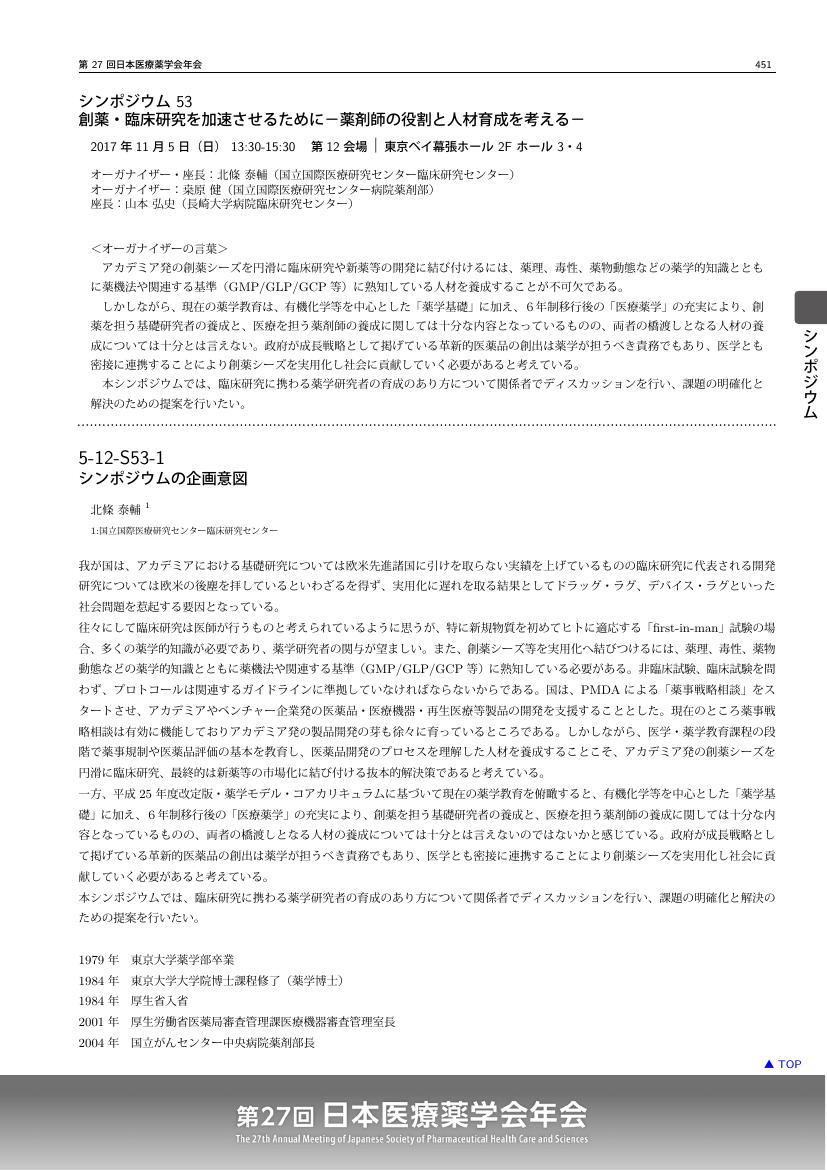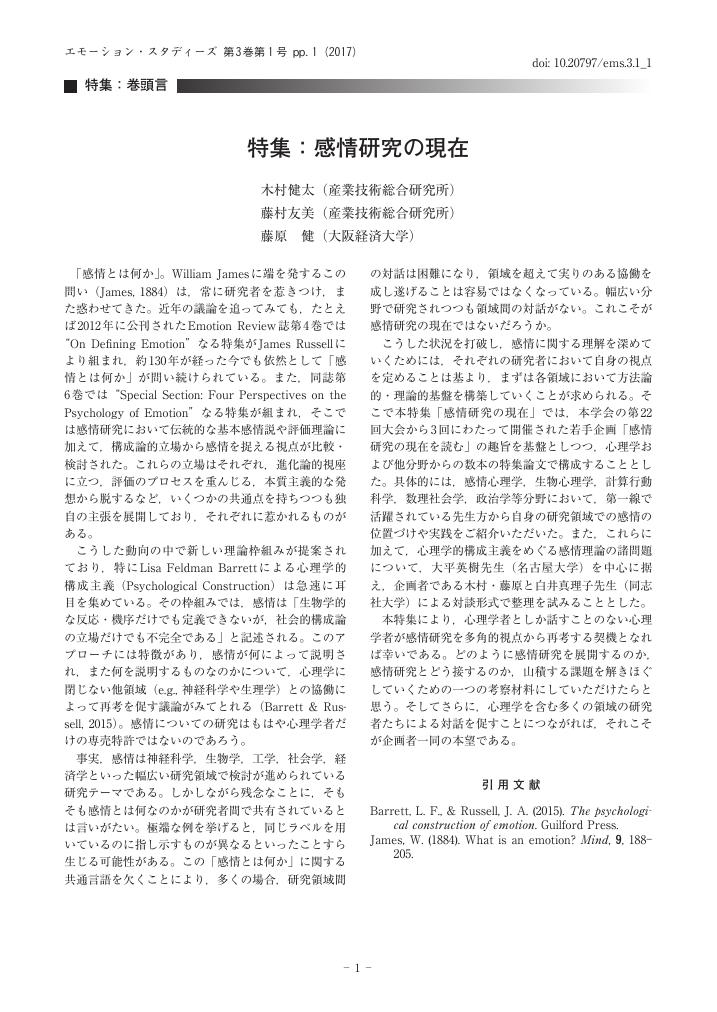2 0 0 0 記憶の想起に基づく創造性支援
- 著者
- 相原 健郎 堀 浩一
- 出版者
- 一般社団法人情報処理学会
- 雑誌
- 情報処理学会論文誌 (ISSN:18827764)
- 巻号頁・発行日
- vol.42, no.6, pp.1377-1386, 2001-06-15
- 被引用文献数
- 1
本論文は,人間の創造的な思考を支援するための手法と,それに基づく支援システムを提案する.まず,創造性についての認知科学研究に基づいた思考過程のモデルを提示し,思考の制約となっているものを変更することで創造的な思考が進むことを述べる.そして,思考の制約のうち,記憶の想起の障害となっている時間的な制約に着目し,それをシステムによってユーザに変更を促すことで創造的な思考を支援することを提案している.提案手法では,時間的な制約を空間的な制約に変換してユーザに提示することで,ユーザの想起を促し,それによって思考を支援することを行う.支援システムEn Passant 2は,思考活動で最もよく用いられる紙に書かれたメモを利用し,それをシステムに入力することで,ユーザの記憶の想起のきっかけを与えるのに利用している.ユーザは,システム上でメモのマークをつけることでメモを特徴づける.それを用いてシステムはメモ間の関連度を算出し,メモを2次元空間上にマップしてユーザに提示する.システムを用いた長期実験を行い,システムの有用性を示している.In this paper,we propose a method and its implementation to aid the process of creative thought.The objective of this research is to enhance the human creativity with computers.This paper deals with a scientific creativity.In order to aid the process of creative thought,we have implemented a system named En Passant 2,which stores the user's research notes.The user can put his/her own mark as an index onto his/her notes in the system.The unique feature of En Passant 2 lies in the function to deal with indices and a time attribute of the user's thought explicitly.Using indices and time information,the system shows the user's notepads related to his/her awareness of the issues.The recall of his/her memories in present context makes a collision of two contexts,and that triggers the user's creativity.We have carried out several experiments and show the results.
2 0 0 0 中国で読まれている科学史漫画(アゴラ)
- 著者
- 島原 健三
- 出版者
- 日本科学史学会
- 雑誌
- 科学史研究. 第II期 (ISSN:00227692)
- 巻号頁・発行日
- vol.39, no.214, pp.118-120, 2000-06-28
- 被引用文献数
- 1
2 0 0 0 OA 特許文献に記載の塩基配列およびアミノ酸配列に関する諸問題
- 著者
- 三原 健治
- 出版者
- 国立研究開発法人 科学技術振興機構
- 雑誌
- 情報管理 (ISSN:00217298)
- 巻号頁・発行日
- vol.54, no.10, pp.652-662, 2012 (Released:2012-01-01)
- 参考文献数
- 8
ゲノムを丸ごと解析できるようになった現在において,DNA配列やアミノ酸配列に関する情報は年々増加の一途をたどっている。特許出願についても配列に関する膨大な情報が蓄積されており,配列データの蓄積方法に加えて,蓄積されたデータを検索等に利用する仕組みも必要である。本稿では上記の配列データの蓄積および検索への利用に関して,以下の4つの問題点,すなわち(1)塩基数またはアミノ酸数の少ない配列の問題,(2)塩基数またはアミノ酸数の多い配列,並びに配列数の多い出願の問題,(3)同じ配列が重複して登録される問題,(4)特許出願における配列表のフォーマットに関して,配列表のXML化に伴う問題を取り上げ,それぞれについて考察するとともに,最後に配列データの信頼性についても考察した。
- 著者
- 蛯原 健介
- 出版者
- 明治学院大学
- 雑誌
- 明治学院論叢 (ISSN:09189858)
- 巻号頁・発行日
- no.705, pp.1-32, 2003-12
2 0 0 0 OA PubMed(文献データベース)を用いたBrainMappingによる脳機能解析
- 著者
- 小原 健志
- 出版者
- 人工知能学会
- 雑誌
- 人工知能学会全国大会論文集 (ISSN:13479881)
- 巻号頁・発行日
- vol.24, 2010
脳卒中後のリハビリテーションで損傷部位の脳機能は重要な情報であるが、文献数が膨大で損傷部位の機能を俯瞰的に見ることは困難である。そこで、米国国立医学図書館 (NLM)のPubMed文献データベースを脳局所の用語と脳機能の用語を同時に検索し、文献の有無により機能を解析した。また、前頭前野については、全文献の抄録をダウンロードし、テキストマイニングで解析し、脳局所の機能情報を可視化可能となった。
2 0 0 0 若年勤労者の出社困難症 : その現状と対応の限界
- 著者
- 津久井 要 江花 昭一 山本 晴義 西川 哲男 川原 健資 天保 英明 境 洋二郎 秋庭 篤代
- 雑誌
- 日本災害医学会会誌 = The journal of Japan Accident Medical Association (ISSN:0386975X)
- 巻号頁・発行日
- vol.47, no.4, pp.219-224, 1999-04-01
2 0 0 0 交通渋滞解消のための大域的及び局所的最適化経路選択手法の性能比較
- 著者
- 大原 健 能島 裕介 石渕 久生
- 出版者
- 日本知能情報ファジィ学会
- 雑誌
- 知能と情報 : 日本知能情報ファジィ学会誌 : journal of Japan Society for Fuzzy Theory and Intelligent Informatics (ISSN:13477986)
- 巻号頁・発行日
- vol.18, no.6, pp.867-873, 2006-12-15
- 参考文献数
- 8
- 被引用文献数
- 3 3
本研究では, 道路状況が動的に変化するために, 道路利用者が経路選択を行う時に個々の経路の走行時間に関する情報が利用可能でないような交通流モデルを考える. このような交通流モデルに対して, 全走行車両の平均走行時間を最小にするために, 2種類の経路選択手法の性能を比較する. 一つは, 大域的に平均走行時間の最小化を行う手法である. この手法では, 全走行車両の経路選択を中央管理者が決定する. 走行車両台数が多い場合では, 走行車両に対する経路選択の組合せ総数が大きくなり, 最適解を求めることが困難になる. そこで本論文では, 遺伝的アルゴリズムを用いることで効率的に近似最適解を求めることにする. もう一つの手法は, 個々の車両ごとに局所的に走行時間の最小化を行う手法である. この手法では, 各車両は, 予測走行時間の短い経路を選択する. 本論文では, ニューラルネットワークを用いて走行時間の予測を行う. 数値実験により, 2種類の経路選択手法を比較し, 各々の手法の特徴を明らかにする.
1 0 0 0 OA 慣行および有機栽培法で栽培した水稲白米の全窒素・アミロース含量およびアミノ酸含量・組成
- 著者
- 王 桂云 阿部 利徳 笹原 健夫
- 出版者
- CROP SCIENCE SOCIETY OF JAPAN
- 雑誌
- 日本作物学会紀事 (ISSN:00111848)
- 巻号頁・発行日
- vol.67, no.3, pp.307-311, 1998-09-05 (Released:2008-02-14)
- 参考文献数
- 12
- 被引用文献数
- 2 4
無農薬・無化学肥料栽培(有機栽培)および慣行栽培した水稲白米の全窒素・アミロース含量およびアミノ酸含量・組成を検討した.白米の全窒素含量は供試した2品種(コシヒカリ, ひとめぼれ)とも無農薬・無化学肥料栽培に比較して, 慣行栽培で有意に高くなった.しかし, アミロース含量は無農薬・無化学肥料栽培米と慣行栽培米とで2品種間に有意の差異が見られなかった.一方, 白米粉末のアミノ酸含量についてみると加水分解アミノ酸は, 慣行栽培の場合の全窒素含量の増加傾向を反映して, 検出できた16のアミノ酸はむしろ慣行栽培で高まる傾向を示した.遊離アミノ酸含量は加水分解アミノ酸含量の1/100ないしそれ以下であった.しかし, 遊離アミノ酸のうちアスパラギン酸, グルタミン酸, アスパラギン, グルタミンがコシヒカリおよびひとめぼれ2品種とも, 慣行栽培に比較して無農薬・無化学肥料栽培で有意に高くなった.以上の結果は, 無農薬・無化学肥料栽培で白米の窒素含量が低下し, 遊離のグルタミン酸, アスパラギン, グルタミン含量が増加することを示している.今後, これらの結果と炊飯米の食味との関係を検討する必要がある.
1 0 0 0 OA 1, 2位に含窒素5員環が縮合した1, 4-ベンゾジアゼピン類の合成とCNS活性
- 著者
- 原 健
- 出版者
- The Society of Synthetic Organic Chemistry, Japan
- 雑誌
- 有機合成化学協会誌 (ISSN:00379980)
- 巻号頁・発行日
- vol.38, no.11, pp.1105-1118, 1980-11-01 (Released:2009-11-13)
- 参考文献数
- 74
- 被引用文献数
- 1 2
This article reviews the syntheses of 1, 4-benzodiazepines with a nitrogen atom-containing five-membered ring fused to the 1, 2-position of the diazepine ring. Recent work on this class of compounds has yielded new synthetic methodologies and compounds (potentially) useful in medicine. Descriptions are arranged according to types of structures of target tricyclic diazepines and to types of approaches in the synthesis. The activity of the compounds on the central nervous system (CNS) is also mentioned. Contents : 1. Introduction, 2. 4H-pyrrolo [1, 2-a] [1, 4] benzodiazepines, 3. 4H-imidazo [1, 2-a] [1, 4] benzodiazepines, 4. 4H-imidazo [1, 5- a] [1, 4] benzodiazepines, 5. 4H-pyrazolo [1, 5- a] [1, 4] benzodiazepines, 6. 4H-s-triazolo [4, 3- a] [1, 4] benzodiazepines, 7. 4H-s-triazolo [1, 5-a] [1, 4] benzodiazepines, 8. 4H-υ-triazolo [1, 5-a] [1, 4] benzodiazepines, 9. 4 H-tetrazolo [1, 5-a] [1, 4] benzodiazepines, 10. CNS activity, 11. Closing comment.
1 0 0 0 OA 個と集合の弁証法の彼方に : ニューディール・リベラリズムと『怒りの葡萄』
- 著者
- 木原 健次
- 出版者
- 日本アメリカ文学会
- 雑誌
- アメリカ文学研究 (ISSN:03856100)
- 巻号頁・発行日
- vol.49, pp.1-18, 2013-03-31 (Released:2017-09-29)
John Steinbeck's The Grapes of Wrath (1939) is one of the representative American novels of the 1930s. Describing the predicament of migrant farmers challenged by the disaster of the Dust Bowl and deprived of their traditional ways of life, the novel is usually thought to epitomize the well-known images of America of the 1930s, such as the "Depression Era" or the "Red Thirties." Not only was it an age of socialist movement and labor dispute, but the 1930s also witnessed broad debates, as Eric Foner puts it, over "the redefinition of freedom" among politicians and intellectuals. These debates, inseparable from the foundation of the New Deal, were no less influential than those of the contemporary left-wingers. This paper clarifies the structure and esthetics of The Grapes of Wrath, one of the "canons" of the 1930s, by reading it against the background of the liberal discourse in the New Deal period. First, I analyze the arguments of Michael Szalay's New Deal Modernism and Sean McCann's Gumshoe America, both of which examine the literature of the 1930s in reference to the culture of liberalism. Through this analysis, I will argue the significance of the discourses on the relation between the whole and its parts, or the group and the individual, in the New Deal era. I then focus on Steinbeck's biological philosophy, integrating and epitomizing non-teleological thinking and the phalanx theory, which are reflected in both the theme and structure of the novel. The former refers to an attitude toward observing things as they are, as opposed to teleological thinking that seeks to explain things through causal nexuses. The latter theory assumes that a group is an entity different from the mere sum of its members as well as individuals being not the mere components of a group. Through interpreting Steinbeck's philosophy within the framework of the New Deal liberalism, I reveal how it is resonant with contemporary liberal discourse of the time. In conclusion, his ideas can be viewed as a response to the concerns for the New Deal governing theory. The following parts of the paper investigate The Grapes of Wrath with an emphasis on its modernist narrative structure composed of the alternating interchapters and narrative chapters. Steinbeck describes anonymous migrant farmers in the former, whereas the latter depicts the specific story of the Joads, as the exemplary migrant family. Preceding studies on the relation between the two sorts of chapters tend to see the Joads as a representative family, stressing the organic unity of the novel. Considering that the narrative chapters thoroughly portray the Joads as "real" rather than "typical" individualists, however, they can be regarded as opposed to the anonymous mass groups in the interchapters. My thesis concludes that the novel is structured over the dialectic between the value of individualism and the newly emerging significance of government, represented in the narrative chapters and interchapters, respectively. Ultimately, the ending scene functions precisely as a conclusion of the novel because it offers an imaginary unity between the opposing values of the New Deal.
1 0 0 0 OA 創薬・臨床研究を加速させるために
- 著者
- 北條 泰輔 桒原 健 山本 弘史
- 出版者
- Japanese Society of Pharmaceutical Health Care and Sciences
- 雑誌
- 日本医療薬学会年会講演要旨集 (ISSN:24242470)
- 巻号頁・発行日
- pp.451-456, 2017-11-03 (Released:2019-03-23)
1 0 0 0 OA 特集:感情研究の現在
- 著者
- 木村 健太 藤村 友美 藤原 健
- 出版者
- 日本感情心理学会
- 雑誌
- エモーション・スタディーズ (ISSN:21897425)
- 巻号頁・発行日
- vol.3, no.1, pp.1, 2017-10-01 (Released:2018-01-10)
- 参考文献数
- 2
1 0 0 0 OA 伝統建築を生きながらえさせる 仕口ダンパーによる木造軸組の制震
- 著者
- 樫原 健一
- 出版者
- 一般財団法人 住総研
- 雑誌
- すまいろん (ISSN:09160671)
- 巻号頁・発行日
- vol.68, pp.26-30, 2003 (Released:2022-05-09)
1 0 0 0 OA P-1-E11 重症心身障がい児(者)への音楽による睡眠効果
- 著者
- 山本 健司 藤原 健一 家納 有美子
- 出版者
- 日本重症心身障害学会
- 雑誌
- 日本重症心身障害学会誌 (ISSN:13431439)
- 巻号頁・発行日
- vol.41, no.2, pp.247, 2016 (Released:2020-08-08)
目的 夜間覚醒中に問題行為(啼泣、自傷、大声)のある患者に対し音楽による睡眠の効果を明らかにする 方法 対象:夜間覚醒中に問題行為のある患者5名 方法:小林弘幸著『ぐっすり眠るためのCDブック』付録のCD音楽を、ベッドサイドにて音量31〜35dBで消灯時間21時〜翌朝7時まで流す。 期間:1)音楽なし 平成27年11月24日〜12月7日の14日間 2)音楽あり 平成27年12月25日〜平成28年1月7日の14日間 評価:睡眠時間、中途覚醒の回数、問題行為の回数、眠剤使用の回数 結果 睡眠時間に変化がなかったのは患者aとbであった、患者aは睡眠時間、中途覚醒の回数、問題行為の回数に変化はなかったが、眠剤の使用回数が減少した。患者bは中途覚醒が増加し、問題行為も増加した。患者cとdは中途覚醒は増加したが、再入眠までの問題が短縮され睡眠時間が増加した。患者eは睡眠時間が減少し、中途覚醒と問題行為も顕著に増加した。 考察 患者aは、啼泣の持続により緊張・チアノーゼ出現するため眠剤を使用していたが、音楽導入後、眠剤の使用回数が減少した。また、患者cとdは、再入眠までの時間が短縮され睡眠時間が増加している。これは音楽により副交感神経が優位となりリラックスできたためと考える。患者bとeは、中途覚醒と問題行為が増加しており、音楽が刺激となって睡眠に悪影響が出たと考える。遠城寺式発達検査の言語理解は10カ月ごろから始まる。音楽により何らかの効果が見られた3名は、患者aは1歳〜1歳2カ月、患者cは2歳〜2歳3カ月、dは10〜11カ月で、言語理解が10カ月以上であった。それに対し患者bは5〜6カ月、患者eは4〜5カ月で、音楽が楽しい刺激となり睡眠の妨げられたと考える。 結論 睡眠を促す音楽は、遠城寺式発達検査の言語理解が10カ月以上の重症心身障がい児(者)に効果がある。
1 0 0 0 OA 水道事業の広域化の歩みと水道法2018年改正 これまでの広域化/ これからの広域化
- 著者
- 梶原 健嗣
- 出版者
- 水資源・環境学会
- 雑誌
- 水資源・環境研究 (ISSN:09138277)
- 巻号頁・発行日
- vol.32, no.2, pp.57-64, 2019 (Released:2020-01-24)
- 被引用文献数
- 1 1
2018年の改正水道法では、集権的広域化の推進が目指されている。しかし、そこには3つの疑問がある。「収入減少下における大量更新」という時代を迎えるなかで、広域化は有効な解決策になりうると言われる。しかし、少なからぬ水道事業者が広域化に消極的であり、中央と現場に乖離があることは重要な問題である。 そもそも、改正水道法は給水収益の減少を水道事業の重要課題に位置付けていた。しかし、その理由を人口減少のみに求めている点は誤りである。議論の出発点に疑問がある。 最後に責任水量制の問題がある。責任水量制の下で進められる統廃合は、ダム水源への依存度を過度に高める形になりやすい。しかし、それは安定給水の確保に必ずしも繋がらない。工業用水で検討されているように、水道用水供給事業でも責任水量制の見直しが必要である。そうしてこそ、財政およびリスク管理という点から、合理的な統廃合が可能になってくるはずである。
- 著者
- 蛯原 健介
- 出版者
- 立命館大学政策科学会
- 雑誌
- 政策科学 = 政策科学 (ISSN:09194851)
- 巻号頁・発行日
- vol.13, no.3, pp.15-28, 2006-03
1 0 0 0 OA 内在化・外在化問題行動はなぜ相関するか ――相関関係の行動遺伝学的解析
- 著者
- 山形 伸二 菅原 ますみ 酒井 厚 眞榮城 和美 松浦 素子 木島 伸彦 菅原 健介 詫摩 武俊 天羽 幸子
- 出版者
- 日本パーソナリティ心理学会
- 雑誌
- パーソナリティ研究 (ISSN:13488406)
- 巻号頁・発行日
- vol.15, no.1, pp.103-119, 2006 (Released:2006-10-07)
- 参考文献数
- 65
- 被引用文献数
- 13 6
本研究は,人間行動遺伝学と双生児研究の方法,とりわけ多変量遺伝分析について紹介し,その適用例として4–6歳児の気質と問題行動の関連性を検討した。双生児の母親142名に対し質問紙調査を行い,子どものエフォートフル・コントロール (EC) および外在化問題,内在化問題についての評定を得た。表現型の相関を検討した結果,外在化問題と内在化問題は中程度の正の相関を示し (r=.55),またECは外在化 (r=−.42),内在化 (r=−.18) のいずれの問題行動とも負の相関を示した。多変量遺伝分析の結果,ECを低めるような遺伝的影響は同時に両方の問題行動のリスクを高めるような働きをすることがわかり,ECの低さが両問題行動の共通の遺伝的素因である可能性が示唆された。また,外在化問題と内在化問題の相関関係には遺伝 (22.8%),共有環境 (53.4%),非共有環境 (23.8%) のいずれもが寄与していた。問題行動間の相関関係への遺伝要因の寄与は相対的に小さかったが,これはECに関わる遺伝要因が両問題行動を正に相関させるように働くのに対し,ECとは関連しない遺伝要因が両問題行動を負に相関させるように働くため,互いに相殺しあった結果である可能性が示唆された。
1 0 0 0 OA 遺伝子組換え大豆から製造された加工食品におけるDNA断片化
- 著者
- 小笠原 健 荒川 史博 穐山 浩 合田 幸広 小関 良宏
- 出版者
- Japanese Society of Food Chemistry
- 雑誌
- 日本食品化学学会誌 (ISSN:13412094)
- 巻号頁・発行日
- vol.10, no.3, pp.155-160, 2003-12-12 (Released:2017-12-01)
- 参考文献数
- 19
さまざまな大豆加工食品における組換え遺伝子の音量とDNA断片化の程度を調べることにより、厚生労働省により通知された公定法記載の定量PCR法の加工食品への適用可能性について検証した。豆腐のように100℃程度で加熱加工された場合は、適用できることがわかった。しかし、市販されている加工食品のように加熱され、物理的力が更にかかるオートクレーブ処理などが行われた場合、あるいは発酵食品の場合、100bp程度までDNAの厳しい断片化が引き起こされることが明らかとなった。従って、これらの加工食品中の遺伝子組換え大豆の定量を行うには95bpより短いプライマー、プローブを開発する必要があると考えられた。
1 0 0 0 OA 高水温処理によるギンブナ卵へのコイ精子の導入とDNAマーカーによる確認
- 著者
- 董 仕 大原 健一 谷口 順彦
- 出版者
- 公益社団法人 日本水産学会
- 雑誌
- 日本水産学会誌 (ISSN:00215392)
- 巻号頁・発行日
- vol.63, no.2, pp.201-206, 1997-03-15 (Released:2008-02-29)
- 参考文献数
- 21
- 被引用文献数
- 12 12
The eggs of a Ginbuna Carassius langsdorfii (all female triploids) were inseminated by the sperms of a common carp Cyprinus carpio. A part of the eggs was treated by heat shock: 40°C for 1.0min at 5min after fertilization.The average of erythrocytic major diameter of offsprings from non-treated eggs was 17.4μm (17.1-17.7μm). The patterns of glucosephosphate isomerase (GPI), RAPD-PCR (random primer: OPA-04, 09, 15), and DNA fingerprinting (restriction endonuclease: Hae III; probe: YNZ 22) in the offsprings were identical with maternal fish.The average of erythrocytic major diameter of offsprings from treated eggs was 20.6μm (20.3-20.9μm). The patterns of GPI, RAPD-PCR, and DNA fingerprinting in the offsprings were composed of all bands of maternal fish and partial bands of paternal fish.Therefore, the results obtained in this study suggest that the offsprings from non-treated eggs were triploid clones, and the offsprings from treated eggs might be tetraploid composed of genome from both parents.
- 著者
- 高木 悦子 小崎 恭弘 阿川 勇太 竹原 健二
- 出版者
- 日本公衆衛生学会
- 雑誌
- 日本公衆衛生雑誌 (ISSN:05461766)
- 巻号頁・発行日
- pp.22-071, (Released:2023-05-10)
- 参考文献数
- 25
目的 本研究の目的は全国における父親を主な対象とするポピュレーションアプローチ事業の実施状況とその内容について明らかにし,地域における父親への育児支援の可能性について考察することである。方法 本研究は2つの調査を実施した総合的な結果の分析である。第一次調査は2020年12月から2021年2月に全国1,741自治体に対し,郵送留め置き法による質問紙調査を実施した。第二次調査として,2021年8月から9月に主な対象者を父親として事業を実施し調査協力を得られた自治体を対象に,ヒアリング調査を実施した。結果 837(回収率48.1%)自治体を分析対象とした。多くの自治体が母子健康手帳交付時と両親学級の一部として父親への育児支援を実施していた。父親向けのリーフレットやパンフレットの配布(P=0.036),両親学級として父親の参加を奨励(P<0.001),父親が参加しやすい日時の設定(P<0.001),父親向けの内容を盛り込んだ内容(P<0.001)の項目で総人口7万人以上の自治体での実施の回答が有意に多かった。そのうち,「主な対象を母親ではなく父親とした育児支援を実施した」に回答した自治体は54自治体,全体の6.5%であった。実施していない自治体の約7割は実施の必要性を認識していた。ヒアリング調査を実施した21自治体では,妊娠中の事業10件と出産後の育児期の事業が12件,両方の実施が1件であった。実施内容は多岐にわたり,地域の強みを活かし,各自治体が工夫を凝らした内容になっており,参加者の評価は概ね良好であった。一方で参加者数の調整を課題とする自治体が多かった。結論 父親は家庭内での育児や家事への参加が奨励されているが,地方自治体で実施されている父親を主な対象とするポピュレーションアプローチ事業は知識や技術を習得する希少な機会となっていた。ほとんどの父親育児支援内容は,母親の支援者として実施されている。今後は父親を対象とした調査をもとに,自治体で実施できる支援事業モデルの提示が望まれる。


